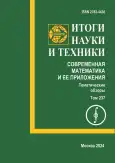Training a Neural Network for a Hyperbolic Equation by Using a Quasiclassical Functional
- Authors: Shorokhov S.G.1
-
Affiliations:
- Peoples’ Friendship University of Russia named after Patrice Lumumba
- Issue: Vol 237 (2024)
- Pages: 76-86
- Section: Articles
- URL: https://journal-vniispk.ru/2782-4438/article/view/274740
- DOI: https://doi.org/10.36535/2782-4438-2024-237-76-86
- ID: 274740
Cite item
Full Text
Abstract
We study the problem of constructing a loss functional based on the quasiclassical variational principle for training a neural network, which approximates solutions of a hyperbolic equation. Using the method of symmetrizing operator proposed by V. M. Shalov, for the secondorder
hyperbolic equation, we construct a variational functional of the boundary-value problem, which involves integrals over the domain of the boundary-value problem and a segment of the boundary, depending on first-order derivatives of the unknown function. We demonstrate that the neural network approximating the solution of the boundary-value problem considered can be trained by using the constructed variational functional.
About the authors
Sergey G. Shorokhov
Peoples’ Friendship University of Russia named after Patrice Lumumba
Author for correspondence.
Email: shorokhov-sg@rudn.ru
Russian Federation, Moscow
References
- Соболь И. М. Численные методы Монте-Карло. — М.: Наука, 1973.
- Филиппов В. М. Вариационный метод решения краевых задач для волнового уравнения // Диффер. уравн. — 1984. — 20, № 11. — С. 1961–1968.
- Филиппов В. М., Савчин В. М., Шорохов С. Г. Вариационные принципы для непотенциальных операторов // Итоги науки техн. Совр. пробл. мат. Нов. достиж. — 1992. — 40. — С. 3–176.
- Шалов В. М. Некоторое обобщение пространства К. Фридрихса // Докл. АН СССР. — 1963. — 151, № 2. — С. 292–294.
- Шалов В. М. Решение несамосопряженных уравнений вариационным методом // Докл. АН СССР. — 1963. — 151, № 3. — С. 511–512.
- Шалов В. М. Принцип минимума квадратичного функционала для гиперболического уравнения // Диффер. уравн. — 1965. — 1, № 10. — С. 1338–1365.
- E W., Yu B. The deep Ritz method: A deep learning-based numerical algorithm for solving variational problems // Commun. Math. Stat. — 2018. — 6, № 1. — P. 1–12.
- Geneva N., Zabaras N. Modeling the dynamics of PDE systems with physics-constrained deep autoregressive networks // J. Comput. Phys. — 2020. — 403. — 109056.
- Raissi M., Perdikaris P., Karniadakis G. Physics-informed neural networks: A deep learning framework for solving forward and inverse problems involving nonlinear partial differential equations // J. Comput. Phys. — 2019. — 378. — P. 686–707.
- Sirignano J., Spiliopoulos K. DGM: A deep learning algorithm for solving partial differential equations // J. Comput. Phys. — 2018. — 375. — P. 1339–1364.
- Young W. H. On multiple integration by parts and the second theorem of the mean // Proc. London Math. Soc. — 1917. — 2, № 16. — P. 273–293.
- Zhu Y., Zabaras N., Koutsourelakis P.-S., Perdikaris P. Physics-constrained deep learning for high-dimensional surrogate modeling and uncertainty quantification without labeled data // Journal of Computational Physics — 2019. — 394. — P. 56–81.
Supplementary files





